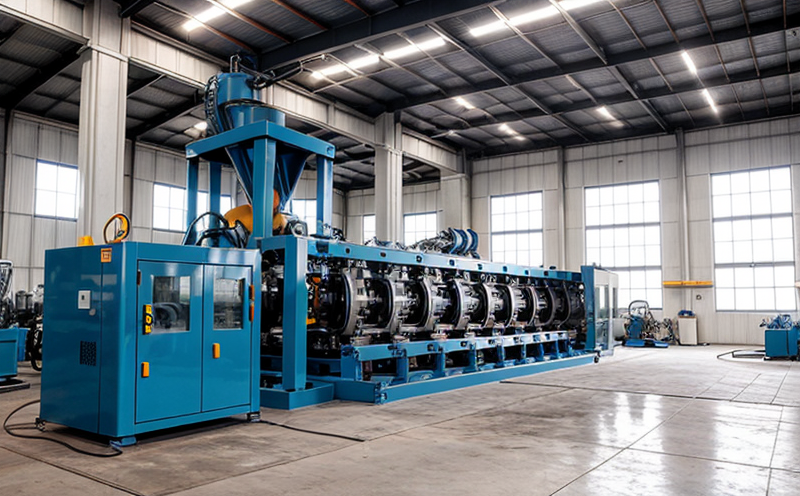ISO 21940 Balancing of Rotating Equipment Testing
The ISO 21940 standard provides a comprehensive framework for balancing rotating machinery to ensure optimal performance and reliability. This service is critical in industrial manufacturing, where precision and efficiency are paramount. In sectors like power generation, aerospace, automotive, and process industries, the balance of rotating equipment can significantly impact operational costs and product quality.
The balancing process involves identifying and compensating for imbalances that occur during the rotation of shafts or other components. These imbalances can lead to excessive vibration, increased wear on bearings and seals, and reduced overall efficiency. By adhering to ISO 21940, we ensure that rotating equipment operates at its highest capacity with minimal stress on the system.
The first step in our balancing process is a thorough inspection of the machinery to understand its specific requirements. This includes assessing the type of rotation, speed range, and any existing conditions that could affect the balance. Once the assessment is complete, we use advanced measuring instruments such as accelerometers and laser vibrometers to gather precise data on the equipment's vibration levels.
Based on this data, our engineers apply corrective measures using balancing techniques like static or dynamic balancing. Static balancing focuses on eliminating any weight imbalances, while dynamic balancing addresses both static and rotating forces. The process involves attaching counterweights or modifying existing components to achieve optimal balance.
The quality of the balancing depends heavily on the precision of the measurements and the skill of the personnel involved. Our team uses cutting-edge technology and follows stringent procedures outlined in ISO 21940 to ensure that every step is accurate and repeatable. This not only enhances product performance but also extends the lifespan of the machinery by reducing wear and tear.
After completing the balancing process, we conduct a series of tests to verify the effectiveness of our work. These tests include checking the vibration levels both before and after the balance correction to ensure that the equipment meets or exceeds the required standards. We also perform operational checks to confirm that the machinery operates smoothly under various load conditions.
Our commitment to excellence extends beyond just meeting ISO 21940 requirements. We work closely with our clients to understand their unique needs and provide tailored solutions. This approach ensures that we deliver not only compliance but also superior performance, contributing to long-term operational efficiency and reliability.
Frequently Asked Questions
Eurolab Advantages
At Eurolab, we pride ourselves on offering unparalleled expertise in the field of balancing rotating equipment. Our team of highly skilled engineers and technicians is dedicated to providing top-notch service that exceeds industry standards. With years of experience and cutting-edge technology at our disposal, we ensure that every client receives personalized attention tailored to their specific needs.
- State-of-the-art measuring instruments for precise data collection
- Experienced professionals with deep knowledge of ISO 21940 requirements
- Dedicated project management teams for seamless coordination
- Comprehensive testing and verification protocols to guarantee quality
- Ongoing support for long-term performance optimization
We understand that every piece of rotating machinery is unique, which is why we take the time to thoroughly assess each client's equipment. This approach ensures that our balancing solutions are not only compliant with ISO 21940 but also optimized for peak performance.
Quality and Reliability Assurance
At Eurolab, quality and reliability assurance are at the heart of everything we do. We have implemented robust processes to ensure that our balancing services meet or exceed international standards like ISO 21940. Our commitment to excellence is reflected in every step of the process, from initial consultation to final verification.
Our quality control procedures include:
- Thorough inspection and documentation
- Precision data collection using advanced instruments
- Application of corrective measures based on detailed analysis
- Comprehensive testing to validate results
- Ongoing support for long-term performance monitoring
We are committed to providing services that not only meet but exceed the expectations of our clients. By adhering strictly to ISO 21940, we ensure that each balancing project is executed with precision and care, leading to increased reliability and extended service life.
Competitive Advantage and Market Impact
The adoption of ISO 21940 balancing services offers several competitive advantages for industrial manufacturing companies. By ensuring optimal performance, these services contribute directly to cost savings, improved efficiency, and enhanced product quality.
- Cost Savings: Reduced wear on components leads to lower maintenance costs and fewer unplanned downtime events.
- Increased Efficiency: Balanced machinery operates more smoothly, reducing energy consumption and extending operational life.
- Better Product Quality: Precision balancing ensures that the equipment performs at its highest capacity, contributing to higher quality output.
- Enhanced Reputation: Compliance with international standards like ISO 21940 builds trust and credibility among clients and stakeholders.
In today's competitive market, companies that invest in high-quality balancing services gain a significant edge. They are better equipped to meet customer demands while maintaining operational excellence. This translates into improved profitability and stronger market positioning.





